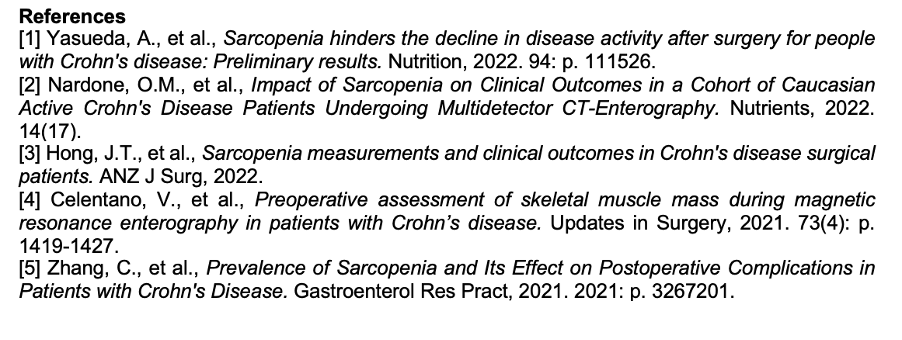Inniss, S.(1,2)*;Simpson, K.(1);Fragkos, K.(1);Wood, C.(1);Smith, A.(2);Rahman, F.(1,2);
(1)University College London Hospitals NHS Foundation Trust, Gastrointestinal Services, London, United Kingdom;(2)University College London, Eastman Dental Institute, London, United Kingdom;
Background
Sarcopenia, a reduction in muscle mass and function, is a poorly recognised phenomenon in Crohn’s disease (CD) despite occurring in 16%-68% of CD patients [1-5]. It has been linked to both an increased need for surgery and increased risk of postoperative complications. However, the role of sarcopenia in CD and its long-term impact on surgical outcomes are unknown. We aimed to assess the link between sarcopenia and postoperative clinical recurrence.
Methods
Retrospective data was collected between 2015 and 2021 from CD patients who had undergone gastrointestinal surgery and a MR or CT scan within 3 months prior to surgery. Follow up data was retrospectively collected for 6 months. MR and CT scans were used to determine skeletal muscle area (SMA) from the cross-sectional L3 vertebrae, which was used to identify patients as sarcopenic or not. Clinical recurrence was defined as a Harvey-Bradshaw Index of 5 or more. Statistical analysis included demographics and inferential analyses. Missing data was attributed to the absence in clinic notes.
Results
This single centre study included 64 CD patients [56.3% male, median age of 30.0 (18.0-76.0), 87.7% non-smokers] who had undergone gastrointestinal surgery. Most patients had ileocolonic CD (74.6%, 47/63) and either stricturing (46.9%, 30/64) or penetrating (31.3%, 20/64) disease behaviour, and 23.4% (15/64) had perianal disease. 45.3% (29/64) of patients had had at least one previous surgery. Preoperatively, 20.6% (13/63) of patients were on steroids and 55.6% (35/63) were on combined drug therapy. Patient median SMA was 113.6 (61.8 – 281.7) cm2 with sarcopenia found in 74.1% (43/58) of patients. SMA was lower in females (females: 92.1±19.3 cm2 vs males: 137±39.5 cm2, p<0.001) and patients with a BMI<18.5 kg/m2 (BMI<18.5 kg/m2: 91.8±19.1 cm2 vs BMI≥18.5 kg /m2: 120.3±33.3 cm2, p=0.004) (figure 1). Postoperative clinical recurrence was observed in 17.8% (8/45) of patients at 6 months. Patients with clinical recurrence had a significantly lower SMA (87.4 ± 18.5 cm2) compared to those without clinical recurrence (120.9 ± 39.2 cm2) (p=0.001) (figure 2). Patients with a lower SMA were 1.1 times more likely to have clinical recurrence at 6 months compared to patients with a higher SMA (OR 1.05 (CI 1.01-1.10)(p=0.022)).


Conclusion
Sarcopenia is highly prevalent in preoperative CD patients. Patients with early clinical recurrence had a significantly lower SMA. SMA may be useful in predicting CD patients at risk of early postoperative clinical recurrence. However, more research is needed to confirm study findings.






